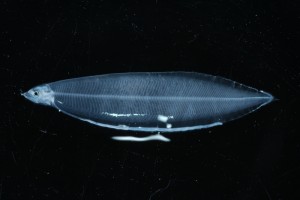What do eel larvae feed on in the ocean? Low trophic position of Japanese eel larvae indicates feeding on marine snow

What eel larvae feed on in the surface layer of the ocean has remained a mystery. Previous studies of gut contents and bulk nitrogen stable isotopes suggested that these larvae, called leptocephali, feed at a low level in the oceanic food web, whereas other evidence has indicated that small zooplankton are eaten.

On what eel leptocephali feed in the ocean remained unknown. This study clearly suggests that natural leptocephali feed on particulate organic matter (POM) such as marine snow, formed of carcasses of various planktons decomposed by microorganisms. © Katsumi Tsukamoto
In this study the nitrogen isotopic composition of amino acids of both natural larvae and laboratory reared larvae of the Japanese eel were determined to estimate the trophic position (TP; the level in the food chain) of leptocephali. A mean TP of 2.4 for natural leptocephali was observed, which is consistent with feeding on particulate organic matter (POM) such as marine snow consisting of dead bodies of phytoplanktons and zooplanktons including discarded appendicularian houses (a form of exoskeleton of protein and cellulose produced by free-swimming planktonic larvacea), bacteria, protozoans and other biological materials. The nitrogen isotope enrichment values of the reared larvae confirm that the primary food source of natural larvae is only consistent with POM.
This shows that leptocephali feed on readily available particulate material originating from various sources closely linked to ocean primary production and that leptocephali are a previously unrecognized part of oceanic POM cycling.
Paper
Michael J. Miller, Yoshito Chikaraishi, Nanako O. Ogawa, Yoshiaki Yamada, Katsumi Tsukamoto, Naohiko Ohkouchi,
“A low trophic position of Japanese eel larvae indicates feeding on marine snow”,
Biology Letters Online Edition: 2012/11/7 (Japan time), doi: 10.1098/rsbl.2012.0826.
Article link






